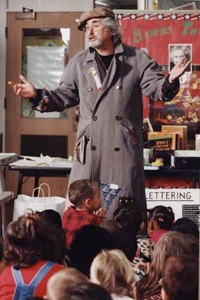 Title: Joseph Had a Little Overcoat
Title: Joseph Had a Little OvercoatAuthor: Simms Taback
Publisher: New York: Scholastic, 2000
ISBN: 0-439-21697-4
Plot Summary: “Joseph had a little overcoat. It was old and worn.” So begins Simms Taback’s adaptation of the traditional Yiddish song “I had a Little Overcoat”. Joseph’s coat is tattered, so Joseph uses his tailoring skills to constantly recreate his favorite apparel into a progressively smaller form. Soon nothing of the coat remains. But that’s not the end! Joseph shows us that something can be made from nothing.
Critical Analysis: Reminiscent
of the song lyrics, the rhythmic text and repeated elements make Joseph Had a Little Overcoat a joy to
both read aloud and hear. The text’s predictable nature also makes it easier to
appreciate the real magic of the book—the illustrations. Taback’s illustrations
place the very poor tailor Joseph as part of an Eastern European Jewish
community sometime during the late 1800’s to the early 1900’s—the very same
culture from which we receive the song.
Using primarily
watercolor and collage, Taback’s spreads are packed with details. Younger
children will delight in giggling at cartoonish figures and in finding the
photographic images in the collage. Older children, including adults, will be
intrigued by all the cultural details—a fiddler on the roof here, a Yiddish
magazine there. However, the real excitement
occurs with the die-cuts. Overlaying every other illustration with a die-cut creates
a jacket from a coat, a button from a handkerchief, and all sorts of items in
between.
The
moral, “You can always make something out of nothing” is lightly presented, but
multi-layered. Creativity and positive attitude will win the day! Joseph Had a Little Overcoat proves it.
Reviews and Awards:
2000
CALDECOTT MEDAL
Barbara Kiefer,
chair of the Caldecott Award Committee, commented, "Vibrant rich colors,
playful details, and skillfully-placed die cuts contribute to the books raucous
merriment that takes this Yiddish folk song far beyond the simple words."
Linda Ludke for School Library Journal writes, “A
book bursting at the seams with ingenuity and creative spirit.”
Publishers Weekly states, “With its effective repetition and an abundance
of visual humor, this is tailor-made for reading aloud.”
Music Video:
See Scholastic’s animation of the song using Taback’s illustrations. The score is authentic klezmer music of the Yiddish original.
http://www.simmstaback.com/Simms_Taback_Videos_-_Joseph_Had_a_Little_Overcoat.html
See Scholastic’s animation of the song using Taback’s illustrations. The score is authentic klezmer music of the Yiddish original.
http://www.simmstaback.com/Simms_Taback_Videos_-_Joseph_Had_a_Little_Overcoat.html
Related Lesson Plans:
In the words of the artist:
“Joseph Had a Little Overcoat is adapted
from a Yiddish folk song and is a good example of yiddishkayt, meaning “Jewish
life or Jewish world-view.” It embodies the values and struggles of life in the
shtetl—the small villages where Jews lived in Eastern Europe. These were not
big-city Jews, but families of farmers and tradesmen of mixed economic classes.”
---Excerpt from Taback’s Caldecott Award
acceptance speech, see more at http://www.simmstaback.com/Simms_Taback_Caldecott_Medal.html
At the end of the book Taback
includes some nice bonus features for the adults and older children. One is a
letter explaining why he chose this particular song to illustrate and his
feelings regarding the finished product. The other is the sheet music (tune
only) to “I had a Little Overcoat”.
A question for you:
A question for you:


3-year-old: Enthralled with the die-cuts
ReplyDelete7-year-old: He was predisposed to like this book as he and the title character share a name. He enjoyed reading it aloud and paused often to examine the pictures.
11-year-old: Full of questions about the cultural references in the illustrations. It was a fun discussion and now we need to re-watch Fiddler on the Roof.